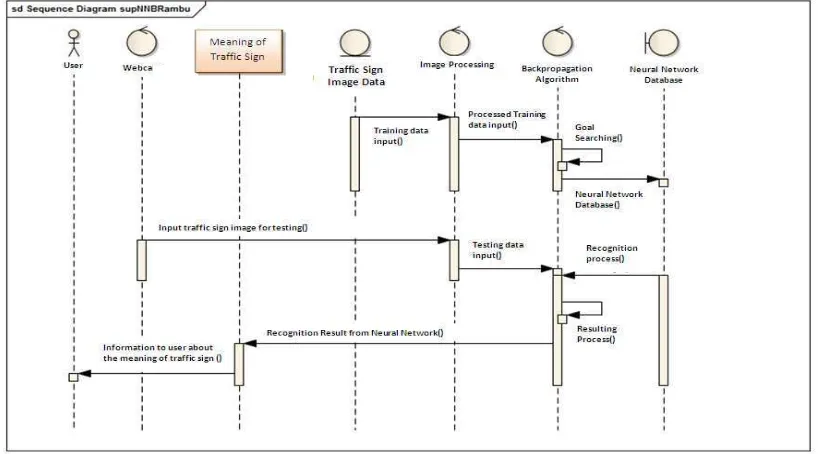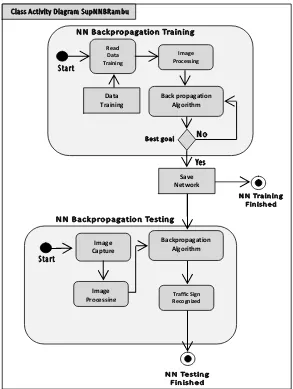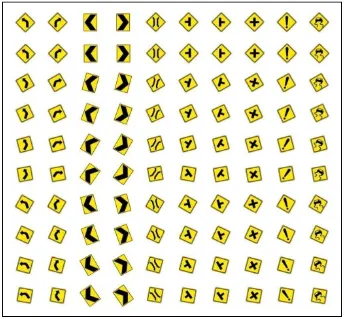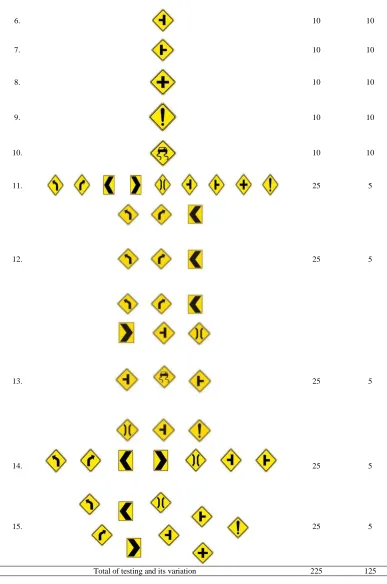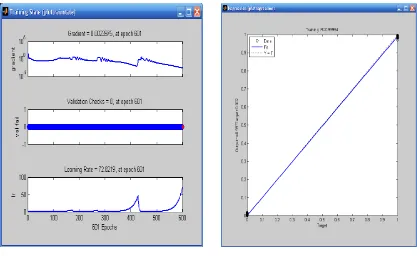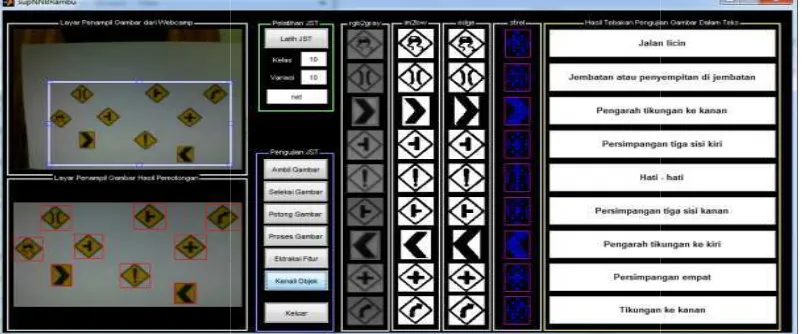ISSN: 1693-6930
accredited by DGHE (DIKTI), Decree No: 51/Dikti/Kep/2010 749
Early Model of Traffic Sign Reminder Based on Neural
Network
Budi Rahmani*, Supriyadi
Department of Informatics Engineering, STMIK Banjarbaru
Jl. Pekapuran B Laut 10 RT. 14 Banjarmasin Kalimantan Selatan 70233, 0511-3271341 e-mail: [email protected]*, [email protected]
Abstrak
Mengenali tanda-tanda lalu lintas yang dipasang di jalan-jalan adalah salah satu kebutuhan berkendara di jalan. Kelalaian dalam berkendara dapat menyebabkan kecelakaan lalu lintas. Makalah ini menggambarkan model pengingat real-time, dengan memanfaatkan kamera yang dapat dipasang di mobil untuk menangkap gambar rambu lalu lintas, dan kemudian diproses untuk diinformasikan kepada sopir. Fitur ekstraksi menggunakan elemen morfologi (strel) digunakan dalam makalah ini. Jaringan Syaraf Tiruan digunakan untuk melatih sistem dan menghasilkan keputusan akhir. Hasilnya menunjukkan bahwa akurasi dalam mendeteksi dan mengenali sepuluh jenis rambu lalu lintas secara real time adalah 80%.
Kata kunci: elemen morfologi, jaringan syaraf tiruan perambatan-balik, rambu lalu-lintas
Abstract
Recognizing the traffic signs installed on the streets is one of the requirements of driving on the road. Laxity in driving may result in traffic accident. This paper describes a real-time reminder model, by utilizing a camera that can be installed in a car to capture image of traffic signs, and is processed and later to inform the driver. The extracting feature harnessing the morphological elements (strel) is used in this paper. Artificial Neural Networks is used to train the system and to produce a final decision. The result shows that the accuracy in detecting and recognizing the ten types of traffic signs in real-time is 80%.
Keywords: back propagation neural network, elements of morphology, traffic signs
1. Introduction
A vision-based vehicle guidance system for road vehicles can have three main roles: (1) road detection; (2) obstacle detection; and (3) sign recognition. The first two has been studied for many years and with many good results, but traffic sign recognition is a less-studied field. Traffic signs provide drivers with very valuable information about the road, in order to make driving safer and easier. The traffic signs mostly play the same role for autonomous vehicles. They are designed to be easily recognized by human drivers mainly because their color and shapes are very different from natural environments [1].
Detection and classification of traffic signs are one of the most studied Advanced Driver Assistance Systems (ADAS) and some solutions are already installed in vehicles. Nevertheless these systems still have room for improvement in terms of speed and performance. When driving at high speed, warning systems require very fast processing of the video streaming in order to lose as few frames as possible and to minimize the chance of missing a readable traffic sign [2], [3].
In the recognition stage, a concept of class similarity measure learned from image pairs is discussed and its realization uses SimBoost, a novel version of AdaBoost algorithm is analyzed. Suitability of the proposed method for solving multi-class traffic sign classification problems is experimentally shown for different feature representations of an image [4].
An implementation of TSR detection is to produce sign, to stop sign, and red-bordered circular sign can be done using these steps. First, image is color segmented based on a threshold technique. Then, corners are detected using convolution masks (optimal corner detector). Geometric constraints are used for shape recognition along verification method for each sign [9], [10].
Neural Network with back propagation algorithm is one of the famous methods to make a learned machine or system that can provide a final decision of classification with a number of learning process. It can be developed by NNtool provided in MATLAB, although sometimes it would result in different accuracies in object detecting and recognition for every experiment [11], [12].
2. Research Method
Figure 1 shown uses case diagram of system. Using the webcam, image of traffic sign will be captured, and processed to be recognized by neural network system. User will get the meaning of recognized image based on trained image sign in advance.
Figure 1. Use case diagram
Figure 2 shows the sequence diagram of system that started from learning process by reading the traffic sign image data. The image data will be processed to be the vector image that can be used as an input of neural network. By neural network toolbox, the best network from certain epoch will be saved, thus it will be used to test the image data. Testing the system using webcam and saved network will produce the recognition image, and user will get information about the meaning of the traffic sign that is recognized [5], [8]. The activity diagram of the process is shown in Figure 3.
Figure 3. Activity diagram system
There are two main activities on Figure 3, i.e. training and testing. On the training activity, the best goal of NN configuration was tried to achieved, and once it was achieved, it will be saved as the best network configuration. The other activity is testing that will be testing the system using a real-time traffic sign image that is captured by using the webcam. The research design is the result from a simple model detector of traffic signs that may be applied for smart car is shown in Figure 4. Webcam is generally used to capture traffic signs and saved in a buffer. Then the image will be selected to separate it from other captured objects. After it has been selected, then it will be cropped, and converted from RGB to grayscale image [13]. The next process is converting the grayscale image into BW image (biner image). The main idea of this research is to convert the BW image to be a 5x7 matrix image. There will be "square" for pixel with value 1 and "dot" for pixel with value 0 (zero) in matrix image. This step is called
"strel", or converting BW (biner) image into its elements of morphology. This step can reduce the complexity of neural network processing in order to learn or to train [14]. Data training set is shown in Figure 5. There are 10 class objects with 10 variation on each by 10º, 20º, 30º, 35º Clockwise and 10º, 20º, 30º, 35º Anti-clockwise.
The following is pseducode of ANN training: a. Pick a training Image file
b. For a number of column and row,
1) convert it into black and white image
2) cut image: look for empty area of image on the top side, right side, left side and bottom side,
3) cropping image
4) convert into biner image 5) extract into matrix image (strel)
c. Make an ANN with this parameter, and start training state
net = newff (minmax (sign),[10 size-target],{'logsig' 'logsig'},'traingdx'); net.LW{2,1} = net.LW{2,1}*0.01;
net.b{2} = net.b{2}*0.01; net.performFcn = 'sse'; net.trainParam.goal = 0.01; net.trainParam.show = 20; net.trainParam.epochs = 5000; net.trainParam.mc = 0.91; P = sign;
T = targets;
[net,tr] = train(net,P,T);
d. Save network for next testing
Figure 4. Research design
The following is pseducode of ANN testing to recognize traffic sign: a. Load saved network
b. Capture image from webcam
1) convert it into black and white image
2) cut image: look for an empty area of image on the top side, right side, left side and bottom side,
3) cropping image
4) convert into biner image 5) extract into matrix image (strel) d. Process with back propagation neural network e. Make a result from the recognized traffic sign
Figure 5. Data training set
Table 1. Testing planning
No. Testing Image Number of
Variation
Number of Testing
1. 10 10
2. 10 10
3. 10 10
4. 10 10
6. 10 10
7. 10 10
8. 10 10
9. 10 10
10. 10 10
11. 25 5
12. 25 5
13. 25 5
14. 25 5
15. 25 5
Total of testing and its variation 225 125
3. Results and Analysis
3.1. Best Performance Training Result
601. Figure 8 shows the training state of the Neural Network Best Training Performance. There are values of gradient, validation check value, and learning rate value at epoch 601. Figure 9 shows the regression of training process to achieve the best performance.
Figure 6. NN training performance Figure 7. Performance of NN best training
Figure 8. Training State Figure 9. Regression
3.2. Testing System with Single Class Image and Multiple Class Image
cropped and converted into g image will be converted into s that will be recognized by Neu in recognizing real time image 86.20%, the result is shown in
Figure 10.
Figure 11. G
Figure 12. G
grayscale image and Black-White image (BW-ima o strel image to be 5x7 pixel image size, and this eural network. According to the last testing, the ac ge for each class is 80%, and real time image of tr in Figure 15.
0. GUI of system testing and recognition result 1
. GUI of System Testing and Recognition Result 2
. GUI of System Testing and Recognition Result 3
mage). Further BW-is BW-is the last image accuracy of system traffic sign group is
Figure 13. G
Figure 14.
Figure 15. Testing s
. GUI of System Testing and Recognition Result 4
4. GUI of system testing and recognition result 5
4. Conclusion
The development of Early Model of Traffic Sign Reminder has been presented. The model has been developed by using the Gradient Descent Back Propagation with Adaptive Learning Rate Algorithm. The system was trained using 10 class image with 10 variation on each by 10º, 20º, 30º, 35º Clockwise and 10º, 20º, 30º, 35º Anti-clockwise of rotation. The result shows that the Neural Network configuration is achieved for the best training performance with value 0.00969 at epoch 601 (iterations) and gradient 0.0023795. According to the last testing, the accuracy of system in recognizing the real-time image for each class is 80%, and real time image of traffic sign group is 86.20%. The author suggests that the system can be re-developed and trained using the next type of traffic sign and saved for a number of network configuration. Serially, the main system can recognize real-time traffic sign using a number of saved network configuration.
References
[1] A. de la Escalera, et. al. Road Traffic Sign Detection and Classification. IEEE Transactions on Industrial Electronics. 1997; 44(6): 848-859.
[2] L. Vazquez, et. al. Fast Real-time Multiclass Traffic Sign Detection Based on Novel Shape and Texture Descriptors. Intelligent Transportation Systems (ITSC) 2010 13th International IEEE Conference. Funchal, Madeira Island, Portugal. 2010: 1388-1395
[3] A. Soetedjo, et al. Fast and Robust Traffic Sign Detection. IEEE International Conference on System, Man and Cybermatics. October.2005.
[4] A. Ruta, et. al. In-Vehicle Camera Traffic Sign Detection and Recognition. Springer-Verlag. 2009. [5] A. Lorsakul, J. Suthakorn. Traffic Sign Recognition for Intelligent Vehicle/Driver Assistance System
Using Neural Network on Open CV. Proceedings of the 4th International Conference on Ubiquitous Robots and Ambient Intelligence (URAI 2007). Postech, Piro, Korea, Nov 22-24, 2007: 279–284 [6] H. Shojania. Real Time Traffic Sign Detection. Report Project on Fall. 2003.
[7] Siti Nurmaini, et al. High Speed Neural Network for Environmental Classification in Mobile Robot Navigation. TELKOMNIKA. 2011; 9(3): 453-464.
[8] Manoj Gupta, et. al. Neural Network Based Indexing and Recognition of Power Quality Disturbances.
TELKOMNIKA. 2011; 9(2): 227-236.
[9] Claus, Bahlmann. et al. A System for Traffic Sign Detection,Tracking, and Recognition Using Color, Shape, and Motion Information. In Proceedings of IEEE Symposium on Intelligent Vehicles. 2005; 255-260.
[10] A. Arlicot, et al. Circular Road Sign Extraction From Street Level Images Using Colour, Shape and Texture Database Maps. International Society for Photogrammetry and Remote Sensing. 2009. Vol. XXXVIII Part 3/W4.
[11] Budi Rahmani, 2D Object Detection Based on Artificial Neural Network. Jurnal Progresif STMIK Banjarbaru. 2012; 8(1): 801-806.
[12] Indar C Gunadin, et al. Steady-State Stability Assessment Using Neural Network Based on Network Equivalent. TELKOMNIKA. 2011; 9(3): 411-422.
[13] Tole Sutikno, et al. Pengenalan Pola Alphabet Tulisan Tangan Secara On-line dengan JST-BP.
TELKOMNIKA. 2005; 3(2): 135-141.
